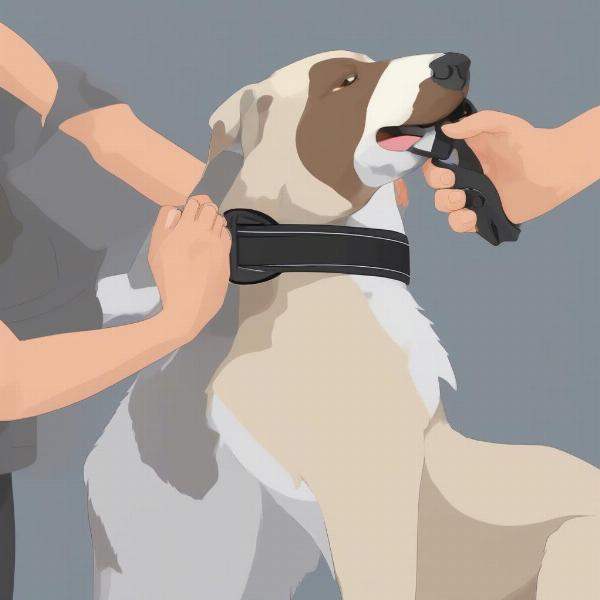Dog shock collars, especially for large breeds, are a controversial topic. While some owners see them as effective training tools, others have concerns about their potential harm. Understanding how these collars work, their potential risks, and exploring humane alternatives are crucial for responsible pet ownership. This guide delves into the world of dog shock collars for large dogs, providing you with the information you need to make informed decisions about your dog’s training and well-being.
Types of Shock Collars for Large Dogs
There are various types of shock collars available, each with different features and intended uses. For large dogs, choosing the right type is crucial to avoid unnecessary discomfort or injury.
- Remote-Controlled Collars: These collars allow the owner to deliver a shock at a specific moment using a handheld remote. This type offers greater control over timing and intensity.
- Bark Collars: Designed to curb excessive barking, these collars automatically deliver a shock when the dog barks. Care should be taken to avoid misapplication and ensure the collar doesn’t trigger unnecessarily.
- Training Collars with Multiple Modes: Some collars combine shock with vibration and beep modes, allowing for a graduated approach to training. These can be helpful for reinforcing commands and addressing specific behavioral issues.
Choosing the Right Shock Collar for a Large Breed
Selecting a shock collar for a large dog requires careful consideration. Factors such as the dog’s temperament, size, and training goals should all play a role.
- Size and Fit: Ensure the collar fits comfortably and securely without being too tight. A properly fitted collar is essential for both safety and effectiveness.
- Intensity Levels: Start with the lowest intensity level and gradually increase only if necessary. Avoid using high levels of shock, as this can cause pain and fear.
- Features and Functionality: Consider the specific features that align with your training needs. Do you need a remote control, multiple stimulation modes, or bark correction?
- Brand Reputation: Choose a reputable brand known for producing high-quality, reliable collars. Research reviews and compare different options before making a purchase.
 Choosing the Right Shock Collar for a Large Breed
Choosing the Right Shock Collar for a Large Breed
Potential Risks and Considerations
While shock collars can be effective, it’s important to be aware of the potential risks involved.
- Pain and Distress: Improper use can cause significant pain and distress to your dog. Overuse or high intensity settings can lead to negative associations and behavioral problems.
- Physical Harm: Incorrect placement or malfunctioning collars can cause burns or other injuries. Regularly inspect the collar for damage and ensure proper fit.
- Behavioral Issues: In some cases, shock collars can exacerbate behavioral problems or create new ones. Fear, aggression, and anxiety can result from inappropriate or excessive use.
Humane Training Alternatives
Positive reinforcement methods are often more effective and ethical than using shock collars.
- Reward-Based Training: Using treats, praise, and toys to motivate desired behaviors is a powerful and humane training approach.
- Clicker Training: This method uses a distinct clicking sound to mark desired behaviors, followed by a reward. It helps build clear communication and positive associations.
- Professional Guidance: Consulting a certified dog trainer can provide personalized guidance and address specific behavioral challenges effectively.
Conclusion
Choosing to use a dog shock collar for a large dog is a decision that requires careful consideration. While they can be effective in certain situations, it’s crucial to prioritize your dog’s well-being and explore humane alternatives whenever possible. shock collar for large dog Understanding the potential risks, proper usage, and available alternatives empowers you to make informed decisions that support your dog’s training and overall happiness.
FAQ
- Are shock collars cruel? While designed to deter unwanted behavior, their misuse can cause pain and distress, making humane alternatives often preferable.
- What is the best shock collar for a large aggressive dog? Consulting a certified professional dog trainer is recommended before using any aversive training tools on an aggressive dog. bark shock collars for large dogs
- What are the alternatives to shock collars? Positive reinforcement methods like reward-based training, clicker training, and professional guidance are effective and humane alternatives.
- How do I choose the right size shock collar for my large dog? Measure your dog’s neck circumference and refer to the manufacturer’s sizing chart for a proper fit. large shock collars for dogs
- Are there any long-term effects of using a shock collar? Improper or excessive use can lead to behavioral problems like fear, anxiety, and aggression. most powerful shock collar for large dogs
- Can I use a shock collar on a puppy? It’s generally not recommended to use shock collars on puppies. Focus on positive reinforcement methods for early training.
- How do I introduce a shock collar to my large dog? Start with the lowest setting and gradually increase only if necessary. Always prioritize your dog’s comfort and well-being. shock collars for large dogs
ILM Dog is a leading international pet website dedicated to providing expert advice and resources on dog care and training. We offer valuable insights into various aspects of dog ownership, including breed selection, health and medical care, training, nutrition, grooming, exercise, puppy and senior dog care, traveling with dogs, and product recommendations. For expert guidance on choosing the right products for your large dog, contact us at [email protected] or call +44 20-3965-8624. ILM Dog is committed to helping you provide the best possible care for your canine companion.